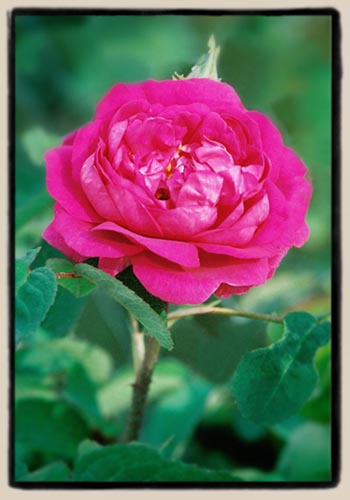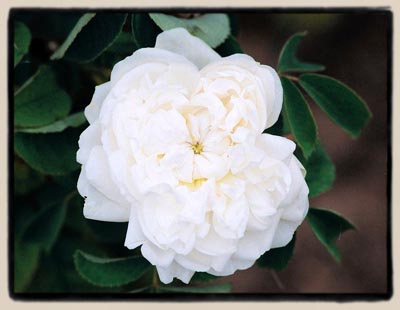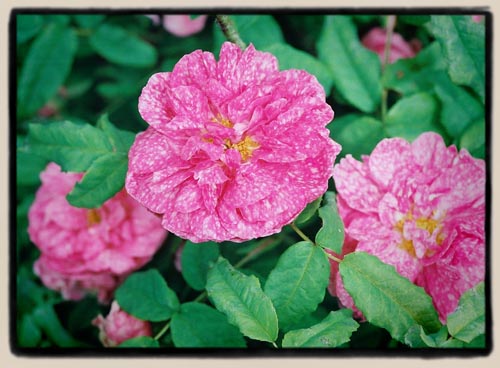 |
|
Albas |
OUT OF THE MISTS OF THE PAST INTO THE MISTS OF THE PRESENT by
Brent C. Dickerson (Part 3) What Andrews--possibly the most turgid and opaque prosaist in Rose literature (other of course than the present author)--is trying to tell us is that he believes that most of the Monthly Roses are in one series, very closely related, but that there is also another sort not so closely related, which would seem to be identifiable with Rossig's 'Bouquet Monatsrose' and perhaps Miller's 'Cluster Monthly' of 1724. Here is Andrews' description of this other clustering Monthly: "Rose, with roundish seed-buds, slightly glandular, peduncles hispidly glandular, often blooming clustered, and of a bright red purple; leaflets are ovate, and villous beneath: the prickles of the branches are scattered and straight. This very desirable Rose was introduced from France under the title of La Rose de quatre Saisons, and which we conceive to be an appropriate term, as it refers with some degree of accuracy to the frequency of its flowering. For although it is not in flower all the year, yet it is found blooming in every season; a circumstance of rare occurrence, and (the Chinese or Indian Rose excepted) only to be found in the species called the Monthly Rose, from which analogy alone, the Rose of the four Seasons has been by many supposed to be only the Cluster red-flowered Monthly under a new name [Andrews refers to his 'Monthly Rose, Cluster-flowered Variety', quoted above]; but to this it has not the slightest affinity except in its foliage, being in every other respect most particularly distinct. It is also a scarce rose, and by no means so well known as it deserves to be. The figure was taken from a fine plant in the nursery of Messrs. Loddiges, Hackney." Ah, how like Andrews to tell us that it is "most particularly distinct" without venturing one word as to how! We see in M'Mahon's The American Gardener's Calendar of 1806 that the red Monthly had reached the New World by that date, as had another variety, 'Italica', which we will examine in due course. The Bon Jardinier of that same year mentions the Monthly's several varieties, "to wit, pink-flowered, pale pink-flowered, and white-flowered. All these varieties are very thorny. The flowers are massed into bouquets of a dozen, sometimes a score, often up until frost." We end our discussion of the Monthly Rose, its progress and its varieties, with Guerrapain's entry for them in his 1811 Almanach des Dames: "Red Tous Mois of Gardeners. The ordinary red 'Tous Mois', grown by all gardeners, has wood a little less prickly [than that of the Damask proper], and does not grow as vigorously. Usually, it bears six to ten blossoms on the same petiole. White Tous Mois. Also much grown by gardeners, this has the same characteristics as the foregoing; it is a little less common, and more delicate in growth . . . [Pink] Tous Mois. Color [of foliage], gray, crowned with double flowers. Wood and leaves like the [red] Tous Mois, less prickly, glaucous green or ashen. Calyx very long, as is that of the Type. Bud round, distinctly tipped with pretty lacinated sepals, which accompany the blossom, projecting beyond it. This one is quite as double as a Centifolia, of a pretty and delicate pink, and blooming around June 10. It should give rise to a number of pretty varieties." And so, we take our leave of the original series of Monthly Roses, with the founder of the clan, the original red variety, firmly on the throne, "grown by all gardeners." 4. 'Portlandica'.The first real diversification of the Monthly Roses came with the appearance of 'Portlandica' (or the 'Portland Rose') by 1775, when Weston lists the 'Portland Crimson Monthly Rose'--and lists it separately from the Monthly Roses group. Andrews reports in 1805 that it is "said" that the rose was named "in compliment to the late Duchess," who would be the second Duchess of Portland, who died in 1785. As I write in one of my books, "as to its origin, the nearest we can come is second-hand information recorded in 1882 by a writer who seems to have a first-hand account at his elbow as he writes: 'At the end of the last century or the beginning of this one . . . was found at Portland, England, a rosebush quite dis-similar to R. damascena bifera, from which came the seed, a seed which was in most probability a hybrid with R. gallica because the new acquisition showed certain resemblances to both species. It had semi-double flowers, scarlet-purple, successively until frost. It was called the Portland Damask'." The rose achieves mention, but only here and there, and rarely at length. Weston, however, had already noted in 1775 that it was "to be readily found," and Buc'hoz provides testimony to its being known in France by 1785. De Pronville, in 1824, gives a quick description, "Damascena Portlandica.--R. de Portland . . . England. Semi-double. Flowers scarlet-purple, coming one after the other until November . . . " Thory and Redoute add a synonym ('Coccinea'), illustrate it, and give a description: "Bushy shrub 0.4-0.5 m tall; stem prickles unequal, closely-set, very fine, recurved, scarcely dilated at the base. Leaflets 5 or 7, ovate, simply dentate, tomentose beneath; petiole villose. Flowers 3-4 at the branch tips, subumbellate, weakly scented; pedicels and receptacles glandular hispid; sepals elongate, spatulate, entire or more often pinnatifid; petals 2-3 seriate, cordately notched, of a beautiful purple color." "Bright red," says Desportes. "Flower deep rose, tinted with purple," advises W. Paul, "large and semi-double; form, cupped. A pretty colour, and most abundant summer bloomer." Louis Noisette records it as, "semi-double, sparkling maroon." But my favorite description is Guerrapain's, of 1811: "One of the most striking by the brightness of its color, and its precious quality of blooming from Spring to Fall. The leaves are oval. The thorns which cover the wood are both long and short all mixed together, hooked, flesh-color on the young wood. The flower buds are pointed and crowned with lacinated leaflets formed by the elongated sepals. This rose, which is only semi-double, is very flashy; its color is a handsome red which makes it distinct and noticeable among all other sorts, especially in the Fall, when no others of that color are to be found. This rose, grafted on the Briar, forms a good head, and is easily contained by pruning." Malo, in 1821, provides some useful remarks: "This rose, generally known as a variety of the Damask Rose, would seem, to Monsieur de Pronville, the link between the Damasks and the Monthlies; its peduncles are very short, such that the three or four blossoms which compose each corymb are crowded, as with the 'Monthly Rose'. its flowers are large, from thirty-two to thirty-three lignes [ca. 3 3/4 inches]; their scent is weak; its corolla is composed of two to three rows of petals; the stamens are very numerous; the styles about one ligne in length [ca. 1/8 inch] and grouped into one lone fascicle; the leaflets, of a delicate green, are more rounded than those of the Damask. The 'Portland Rose' blooms in June, July, September, October. Monsieur Bosc allots the 'Portland Rose' to the Provins roses." 5. 'Bifera'.
We know that this is distinct from the shorter 'Monthly Rose', because Rossig himself has a separate entry for that rose in his first volume of Die Rosen in 1802, which entry moreover refers to his other paragraphs on it in his earlier work, the OEkonomische-Botanische Beschreibung of 1799, which latter does not mention the 'Bifera'. Prevost fils lists it in 1829 as 'Rosier Bifere a Fleurs Roses', also citing "its old name at Rouen," 'Rosier Perpetuel a Fleurs Roses', as well as Vibert's listing as 'Quatre Saisons Rose', and gives the following description: "Canes upright, vertical. Serration simple, villose, non glandulose. Flower medium-sized, loosely double ["multiple"], light pink. This rose only blooms two times a year." And so, what date do we assign 'Bifera'? "Possibly 1805," thinking of Persoon. "Certainly pre-1820," is safest. But perhaps we can hold out wistful hopes for a much older date, at least in the Mediterranean region. Tradition and some indications argue that this was one of the plants distributed by the Franciscan missionaries as they moved into California in the latter part of the 1700s and early 1800s. One thinks of the reblooming rose Montaigne found at the Jesuits' establishment in Ferrara; could this be the same variety which the Franciscans brought from Spain and cultivated later? Further, Rossig's (and presumably Persoon's) assigning a Syrian/Palestinian homeland to the rose could indicate knowledge of its having been imported from possible millennia of growth there; a plant known in the Levant could easily have been brought to Spain during the Moorish period, which ended less than a century before Montaigne found that reblooming rose in Ferrara, Italy. The roses of the Mediterranean and of the Muslim world make up a subject ripe for study.
6. Progress through 1812.
Italy, which has accompanied us since the beginning of our Damask Perpetual
saga, continues to lurk in the background to the end. 'Italica', syn.
'D'Italie', 'Quatre Saisons d'Italie', 'Rose d'Italie', 'D'Italie Rose',
'Damascena Italica', was received by about 1806 by Dupont from Florence,
Italy. We receive rather full reports from Thory and Redoute on the
one hand, and Prevost fils on the other. First, Thory/Redoute: "Sparse
bush about 0.6 m high; prickles very numerous, small, short,
unequal, almost straight. Leaflets 5 or 7, large, ovate, bright
green, simply serrate, glabrous above, paler and slightly tomentose
beneath and on the margins; petioles villose, with small yellowish prickles;
stipules fairly broad, acute, gland-edged. Flowers in threes
at the tips of the branches; bracts subtending the lateral pedicels
elongate, acute; pedicels and receptacles glandular hispid; sepals
longer than the petals in bud, 3 pinnatifid, 2 entire; petals
4-5 seriate, large, soft pink, paler towards the base, cordately notched.
Hips elongate-ovoid, red. This rose sets itself apart among the
Damasks by the large size of the flowers, often over 7.5 cm in diameter,
but only on its own roots since the size is noticeably smaller on grafted
specimens. Du Pont received it from Florence twenty years ago and distributed
it. It has little perfume, but makes up for this by its grace and elegance.
Although long known, it is still rare, but can be seen grafted in Catel's
fine collection. On its own roots it is tender and needs full sun."
At right: 'Blanc de Vibert' A 'De Naples' is ascribed to Descemet ca. 1810; but no one has yet been able to find a description of it! Similarly rare in the literature is 'Douce Melie' (Lelieur, pre-1810); but Desportes saves us from complete ignorance about it: "Flowers delicate pink." Somewhat better known is 'Henriette', which arrived in France from Italy by 1811. This is very possibly synonymous with 'Italica'. You decide. We quote Guerrapain, from 1811, then his disciple LeRouge, from 1819. First, Guerrapain: "Wood strong and vigorous, not very many thorns. Leaves very beautiful, deeply cut, gay green. Calyx big, elongate, glabrous, tip constricted. Bud pointed, beautiful shape, overtopped by its sepals, seven or eight on the same stem. The blossom is large, not very double, but well formed, a beautiful delicate pink, very fragrant, blooming from June 10 to 15. A single stem, with its leaves and half-open buds, makes a nice bouquet." Now, LeRouge: "This variety of the Damask Rose came to us from Italy; wood strong, vigorous, clothed with few thorns; its leaves are a light gay green; calyx fat, elongate, and glabrous. Buds pointed and well covered by the extension of the calyx, seven or eight on the same peduncle; flower large, and not very double, well formed, of a delicate color of pink, very fragrant. One lone branch, accompanied by its leaves, buds, and blossoms, can make a perfect bouquet of the nicest appearance. Opens from the 10th to the 19th [of June]." About the same time, 1811, two more Damask Perpetuals appeared, of which we only know the names--which, fortunately, are slightly descriptive. There is the 'Hybride a Bois Lisse'--i.e., "smooth-wooded hybrid" (no thorns); and there is the 'Hybride a Fleurs Blanchatres'--the "hybrid with whitish flowers." We look forward to learning more about these. We complete our survey with 'D'Italie Blanche' (Carlet/Coquerel, ca. 1812), about which Prevost fils fills us in: "Sport of ['Italica'], enfixed at Rouen around 1812 by Monsieur Carlet, in the garden of Monsieur Coquerel. Leaves paler than those of ['Italica']. Bud flesh. Flower medium-sized, lightly double ["multiple"], fragrant, of a beautiful white."
7. Summary and Conclusion.
The difficulties with this most problematical of groups must be made explicit. First, the contribution of Italy is obscure and must be clarified. Second, the interchangeability of names (Monthly Rose, Tous les Mois, Omnium Calendarum, Quatre Saisons, Bifera, etc. in their various translations and forms in English, French, Dutch, Latin, and German), any or all of which may be applied to any or all of them at any time in the early period, masks the varieties and literally confuses the development of the various lines. Third, comparisons to the elusive 'Common Damask' obscure the nature of the earliest authors' concept of what the original 'Monthly Rose' looked like; indeed, the plant seems to loom larger for the early authors, dwindling to "not over three feet" by the 1790s--and yet it appears that it is the same rose early and late (certainly, Miller knew of it continuously from 1718 through the middle of that century, in the beginning seemingly what Liger and La Quintinye had known, and later seemingly what Weston, the various Abbes, and Rossig knew). Fourth, the origin of 'Bifera' remains a strange mystery, suddenly appearing in the English/Dutch/French/German horticultural matrix between 1805 and 1820. That it is not the original red 'Monthly Rose' or any of its varieties seems clear from Rossig's work; and the distinction seems to be made explicit once again by Rivers (who was indeed familiar with the rose scene at the time of Rossig's latest work, producing his own first crop of seedling roses about 1820) when he differentiates "our very old Damask Rose, the Red Monthly" from "the comparatively new rose, 'Rose a Quatre Saisons' of the French." It was evidently this old Red Monthly, "grown by all gardeners,' which, with the Common China, parented the original Bourbon Rose. Thus we see that, even aside from the importance of their intrinsic beauty, the original 'Monthly Rose' played a double role in the development of the mainstream modern rose, by contributing on one side directly as a Damask Perpetual, and on the other side through the Bourbons and Hybrid Bourbons. No rose has played a more important role in rose progress; and very few have played an equal role! 8. Table. The First Nineteen Damask Perpetuals.Damask Perpetuals Chronologically through 1812. (As always, we use "breeder" as inclusive of "enfixer of sport.")
9. Note and Acknowledgments.Though it is said that the well-known 'Rose du Roi' has been found on a listing of circa 1810, I believe that there must be confusion between the Damask Perpetual and some other obscure rose of the same name. Ecoffay, the originator of the rose, is not known to have released any roses before 1814, when he indeed released another Damask Perpetual; and the fact that Guerrapain, in 1811, who loved Damasks and Damask Perpetuals, and who kept up with new developments in rosedom, did not mention such an important and impressive rose itself speaks volumes by its silence.Finally, research for this article brought me far, far afield from my usual haunts and materials. I wish to express warmest thanks to Karl King (who, among other valuable contributions, found the early Rea reference), Simone Nguyen, and Robert Stonehouse for their important, essential assistance in this effort to dissipate the heavy mists surrounding the early years of the Damask Perpetuals. THE END Best Wishes, --Brent C. Dickerson Web Site: http://www.csulb.edu/~odinthor
There
have been |
|


 At
left: '
At
left: '
 At
left:
At
left: 